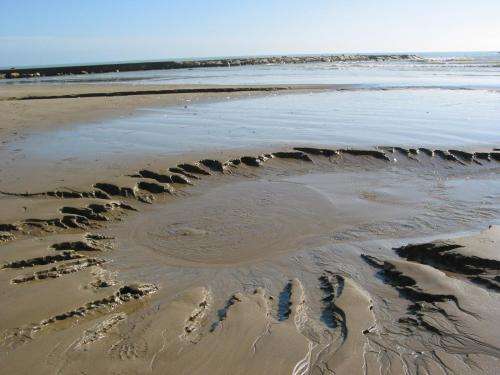Submarine groundwater discharge adds as much nutrients as rivers to the Mediterranean Sea

Submarine groundwater discharge (SGD) consists of a mixture of continental freshwater and seawater, which recirculates through the coastal aquifer. In addition to its importance in the water cycle, as a potentially exploitable water resource and a source of water for brackish coastal environments such as marshes and coastal lagoons, it also can serve as an important source of dissolved chemical compounds such as nutrients and trace and toxic metals.
Now, a study led by researchers from the Institute of Environmental Science and Technology (ICTA) and the Department of Physics of the Universitat Autònoma de Barcelona (UAB) has been the first to calculate the magnitude of SGD into the Mediterranean Sea, as well as the flux of dissolved nutrients. The research, published in Proceedings of the National Academy of Sciences (PNAS), also included the participation of researchers from the Bar-Ilan University of Israel (BIU; Ramat-Gan).
The study shows that the annual volume of SGD for the whole Mediterranean basin ranges from 30 to 500 billion cubic metres, which proves that this process is relevant at large scale and its discharge is similar or up to 15 times greater than that of river water inputs. The flux of nutrients associated with this discharge consists of an annual median of three million tonnes of nitrogen, twenty thousand of phosphorous, and three million of silica, which represent a magnitude of inorganic nutrients comparable to that of external sources traditionally considered in marine studies, such as the atmospheric deposition and riverine runoff.
"The magnitude of SGD and fluxes of associated nutrients demonstrates their relevance in the biogeochemical cycles of the Mediterranean Sea, making it even more necessary to include this, until now, ignored process in future marine studies, both at coastal and global level. These fluxes could have a large influence in coastal environments, especially in areas with low availability of nutrients and in semiarid regions, such as the Mediterranean Sea," explains Valentí Rodellas, UAB researcher who led the study as part of his PhD thesis.
"The entrance of inorganic nutrients associated to SGD can be particularly relevant for the marine ecosystems of coastal areas located further away from river mouths, since SGD may be the only continual source of inorganic dissolved compounds reaching the sea in such areas", explains Jordi Garcia-Orellana, UAB researcher and co-author of the study.
Pere Masqué, also co-author of the study, adds that, "in addition to nutrients, SGD can play a crucial role as a source of other dissolved compounds flowing into the Mediterranean Sea, as well as in all the oceans worldwide, such as carbon, iron and other micronutrients, given the magnitude of the calculated fluxes and the high concentration of these compounds in groundwater".
To conduct the study, researchers used Ra-228, a natural radioactive tracer that is ideally suited for quantifying the submarine groundwater discharge into the sea at basin level. The application of this method required the participation in several oceanographic cruises in order to evaluate the distribution of Ra-228 throughout the water column of Mediterranean Sea.
More information: Submarine groundwater discharge as a major source of nutrients to the Mediterranean Sea, Valentí Rodellas, DOI: 10.1073/pnas.1419049112
Journal information: Proceedings of the National Academy of Sciences
Provided by Universitat Autonoma de Barcelona

















